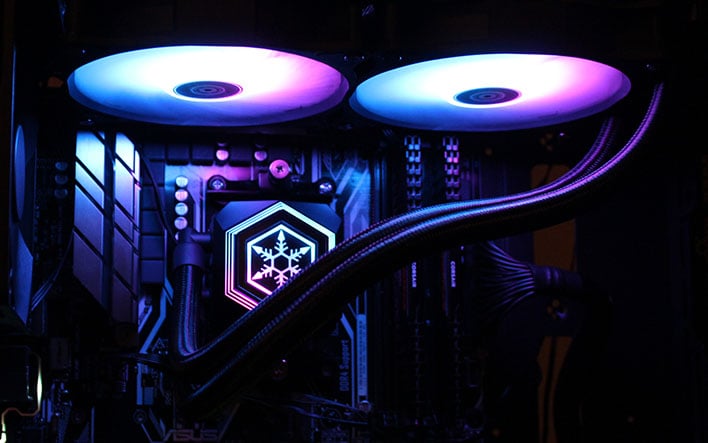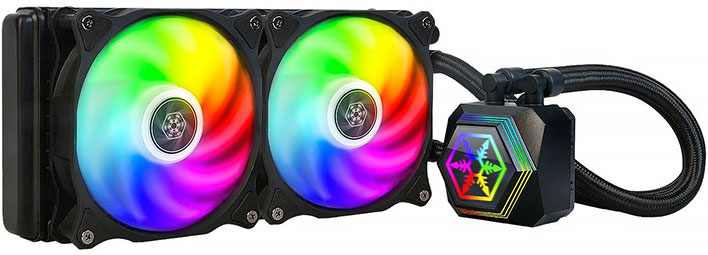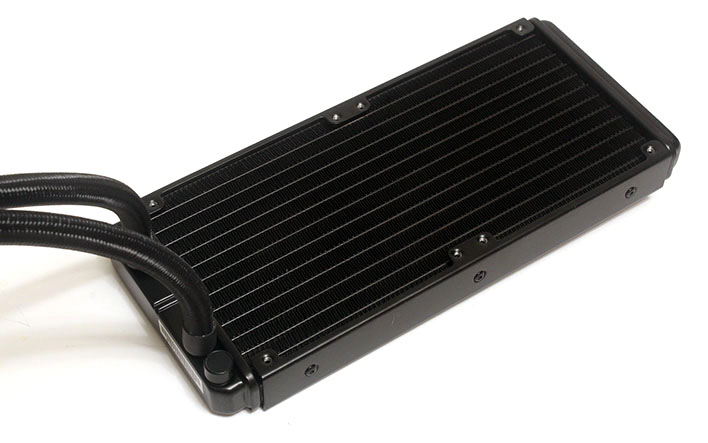SilverStone PF240-ARGB Liquid Cooler Review: Value And Style
SilverStone PF240 ARGB Liquid Cooler: RGB Style With Serious Cooling Substance
SilverStone has been in the AIO (all-in-one) liquid cooling game since 2013, so the cooler we're reviewing today should be a fairly refined product with years of deep feedback and iteration built in. Back in the day, closed loop, AIO liquid coolers were relatively limited in terms of options, but SilverStone was able to distinguished itself by having a unique full alloy water-block that was constructed with a copper base, along with an aluminum body. The cooler also featured brazing fins, similar to those of air coolers, for increased heat transfer. It was initially well received, but was ultimately sidelined due to a myriad of small issues. 2020 is a long way from 2013 though, and since then SilverStone has released multiple coolers, with each new version improving on the previous generation.
The latest all-in-one liquid cooler to be released by SilverStone is the Permafrost Series (PF for short) and the version we're looking at here is the SilverStone PF240. Like its previous AIO coolers, SilverStone is trying to distinguish its products from the competition by employing features that are unique in the market. According to SilverStone, its Permafrost coolers all come with a multi-chamber cooling block design that isolates hot and cold liquid channels to prevent heat bleeding, and thus enables more efficient CPU cooling.

The pump motor also utilizes a three phase, six pole design for smoother, quieter operation and the radiator is automotive grade quality. So, at a bare minimum, this new AIO cooler should have excellent anti-corrosive properties, be strong enough to prevent leaks and operate with a minimal acoustic profile.

The pump motor also utilizes a three phase, six pole design for smoother, quieter operation and the radiator is automotive grade quality. So, at a bare minimum, this new AIO cooler should have excellent anti-corrosive properties, be strong enough to prevent leaks and operate with a minimal acoustic profile.
As always you can find the full specs below...
|
| Cooling Warranty | Five Years |
| Cooling Plate Material | Copper |
| Radiator Material | Aluminum |
| PWM | Yes |
| RGB Compatibility | Gigabyte RGB Fusion, MSI Mystic Light Sync, ASUS Aura Sync, Razer Chroma, RGB Addressable |
| Radiator dimensions | 277mm x 120mm x 27mm |
| Fan dimensions | 120mm x 25mm |
| Fan Speed | 400 to 2400 RPM |
| Number of fans |
2 |
| Cooling socket support |
Intel 115x, Intel 2011/2066, AMD AM3/AM2, AMD AM4, AMD TR4 |
| Lighting |
RGB |
| Radiator size |
240mm |
| Fan model |
ML Series |
| Airflow | 94 CFM |
| Noise Level | 37 dba |
| Fan static pressure |
4.2 mm-H2O |
| Pricing | MSRP $99 - Find It At Amazon |
The SilverStone PF240 comes stock with fully integrated addressable RGB lighting for both the water block and fans. This means the entire unit will have synchronized and coordinated colors from the jump. The color scheme can be changed via an included RGB controller that can switch between 10 lighting modes. The controller also has the ability to adjust brightness and the speed at which the colors change. 3rd party software like Gigabyte RGB Fusion or ASUS Aura Sync for motherboards can be used to change the ARGB lighting as well, but at this time SilverStone doesn't have any proprietary software of their own available.
SilverStone's Permafrost series hit the market in late 2019 in three distinct flavors; the PF120, PF240 and PF360. All use the same cooling block, automotive grade radiator, and ARGB lighting. Where they do differ is in the size of the radiator. The PF120 comes with a 120mm radiator, the PF240 has a 240mm radiator, and the PF360 has a 360mm radiator. The price of these units range from $79.99 to $129.99, which is quite competitive, considering most ARGB liquid coolers on the market run anywhere from $20 to $40 more, depending on brand and size.
Of course, ARGB lighting and alleged advantages in cooling design are only a small piece of the puzzle. The Permafrost series also has to perform as well, so let's look a bit deeper into this cooler and then fire it up...
Of course, ARGB lighting and alleged advantages in cooling design are only a small piece of the puzzle. The Permafrost series also has to perform as well, so let's look a bit deeper into this cooler and then fire it up...
SilverStone PF240 ARGB AIO Cooler Design, Build Quality And Installation
Below we'll break-down the SilverStone Permafrost series, to see what may or may not make it stand out from other AIO coolers on the market. In addition, we'll cover the installation experience a bit as well.
Beyond a unique pump cover the SilverStone PF240 looks like most closed-loop coolers. It features a solid black design, with a 240mm radiator and braided tubing. While it doesn't scream unique, the quality of the entire cooler does appear to be and feels top-notch. The only exception being the pump cover, which isn't as sexy perhaps as offerings from Corsair, or NZXT. The cover just doesn't use the same high-quality material as the aforementioned brands and the glossy mirror on the cooling block only looks good when its ARGB lights are on.
The PF240 features a 240mm automotive grade quality radiator. The radiator is 15.7-inchs long and features sleeved EPDM (ethylene propylene diene monomer) rubber, similar to most AIO liquid coolers on the market. It has a 20 FPI (fins-per-inch) rating and arrived with no damaged, or bent fins in quality packaging.
The cooling plate is made of a one piece copper block that features a flat exterior along with internal micro-fins that evenly distribute the liquid flow for improved heat dissipation. The cooling plate is nothing new though. Most AIO coolers on the market use the same design, but it does include a unique multi-chamber design that reduces heat bleeding between cool and returning warm liquid inside the water block.
The SilverStone Permafrost series feature a hexagonal pump cover with a diamond shaped mirrored surface. When powered on, the hexagonal rings around the mirror feature full ARGB lighting and a SilverStone logo appears though the mirror. When the lights are off the PF240 kind of feels like Las Vegas in the day time. When they're on though, viva Las Vegas!
The included ARGB fans have an operational range between 600 and 2200 RPM. At max RPM they output 35.dBA and have a max airflow of 94 CFM. That's actually quite impressive. To give you a comparison, the fans included with the Corsair H100 ARGB cooler have a higher decibel rating of 37dBA, along with a much lower maximum airflow rating of 75 CFM.
The fans are secured to the radiator via large screws that thread through both the fan and the rad. To prevent the fans from vibrating and causing unwanted noise, each corner also has a rubber anti-vibration pad.
Unlike most other companies, SilverStone includes a tube of thermal paste with the PF240 cooler. Most coolers have a single use layer of thermal paste on the cooling plate, so if you need to remove it for any reason, you'll need to get more thermal paste. Granted there's not a ton of thermal paste included with this cooler, but there is enough to get at least two uses out of. Nice touch, SilverStone.
Installing the PF240 is extremely straight forward. Curiously though, there was no installation paperwork included with the cooler. This isn't a big deal because all the necessary instructions are easily found at SilverStone's website. In the end, not biggie but we feel like most DIY PC builders would prefer having the paperwork available. Except for hippies, but are they really using computers anyway? We kid, honest.
We're using an ASUS Prime x370 Pro AM4 motherboard to test the PF240. By default, the PF240 is setup for installation on an Intel system. Getting it ready for AMD is a simple affair though. All you need to do is remove the per-installed bracket attached to the pump cover and you're off to the races. As for the motherboard, you can leave the stock AMD retention bracket in place. All you have to do is get the proper clips secure them to the pump and screw them down.
As you can see, the cooling block leaves plenty of clearance for memory, VRM and graphics cards. This is really one of the main advantages over air-cooling, beyond the intrinsic superior benefits of liquid cooling that is. And with that in mind, let's look at performance, next...
As you can see, the cooling block leaves plenty of clearance for memory, VRM and graphics cards. This is really one of the main advantages over air-cooling, beyond the intrinsic superior benefits of liquid cooling that is. And with that in mind, let's look at performance, next...
















